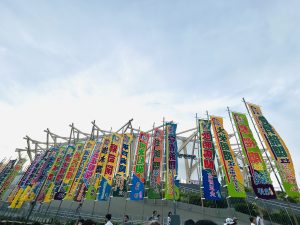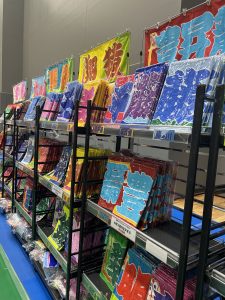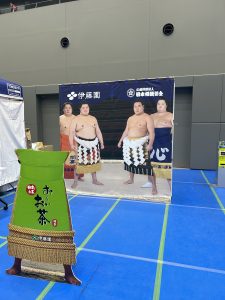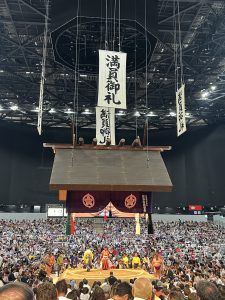人生一度の貴重な機会(愛知県名古屋市千種区姫池通 骨董買取 古美術風光舎)
2025.08.03
今朝の通勤途中、前からカラフルなものが走ってくると思っていましたら、タイなどの東南アジアでよく見かける三輪タクシーの「トゥクトゥク」でした。運転手も乗っているお客さんも外国の方のように見えましたが、皆さんニコニコと楽しそうでした。ナンバープレートを取得すれば日本でも公道を走れるのだそうです。
風を受けながら疾走するトゥクトゥク、一度は乗ってみたいと思っていましたが、名古屋でも乗れるとは!本当はタイに行きたいところですが、日本で体験するのもいいかもしれません。今は珍しいのでかなり人目を引くとは思いますが。
以前ブログでも書きましたが、最近は人生で一度は体験したいと思うことが増えました。「迷ったらとりあえずやってみる」精神を心掛けています。先日も相撲好きの友人に大相撲観戦に誘われ、今までなら「そこまで相撲に詳しくないし…」などと考えて二の足を踏むところですが、「人生で一度」モードに入っていますので二つ返事でお誘いを受けました。
7月27日に終了した名古屋場所は新設された「愛知国際アリーナ」、通称「IGアリーナ」で行われました。イギリスの金融サービスIGグループが10年間を期限とした命名権を取得したとのことです。最大収容人数は1万7000人、天井の高さは30mというアジア地域で最大規模の多目的アリーナとなっています。他の相撲会場に比べ天井があまりにも高いので慣れない緊張や違和感があると感じた力士もいたようです。
地下鉄の名城公園駅とも直結していてとても便利な立地となっています。


昼過ぎに会場に入ったのですが既にお土産売り場などは賑わっており、ちゃんこなどの飲食の販売や特設写真コーナーも設置され、まるでコンサート前のような雰囲気でした。友人も推しの力士のタオルを2枚購入しておりました。


会場は私が想像以上していた以上に熱く盛り上がり、推しのタオルを掲げた人たちの声援が響き渡っていました。春場所で優勝を果たし、横綱に昇進した大の里が40歳の玉鷲に負けた時は座布団が激しく飛び交いうことに。テレビでは見たことがありましたが、「座布団は投げないでください」という事前の放送にも関わらず、大量の座布団が投げ込まれることに驚きました。ルールに従順だとされる日本人も相撲となると熱くなってしまうのでしょうか。
それにしても40歳、大ベテランの玉鷲の土俵際のふんばりには感動しました。名古屋場所では11勝4敗の好成績を残し殊勲賞を最年長記録で受賞。若い力士と闘うのが楽しいのだそうです。すっかりファンになってしまいました。
他にも目を奪われたのが土俵入りの際の豪華な化粧まわし。力士の好みや出身地にちなんだデザインが西陣織や博多織で金糸銀糸などを使って刺繍されています。大変豪華なのですが、時にはドンキホーテのキャラクター「ドンペン」の柄などもあり、自由度が高いのです。かつては「キン肉マン」や「くまモン」「北斗の拳」「鉄腕アトム」などのデザインもあったそう。値段は100万円から数千万円するものもあり、過去にはダイヤモンドが織り込まれた1億円超えの化粧まわしもあったのだとか。
化粧まわしは土俵入りで使用するために作られたものだと思っていましたが、昔は土俵入りをする時も相撲を取る時も同じまわしを使っていたのだそうです。まわしの豪華さを競ううちに、手が絡むなど取組の邪魔になるようになったため江戸時代の宝暦年間(1751年から1764年)の頃に、土俵入り専用のまわしとして化粧まわしが作られるようになりました。それにより化粧まわしは更に長く豪華なものになっていきます。
当時相撲に熱狂していた「タニマチ」と呼ばれる大名たちが、ひいきにする力士を召し抱え、勝利したご褒美に美しい「まわし」を贈るようになります。力士の勝利は大名の知名度アップにもつながり、力士は藩の広告塔の役目も果たしていたと考えられています。
そんなカラフルな化粧まわしが並ぶなか注目を集めたのが、尊富士の真っ黒なデザインの化粧まわしです。よく見ると八咫烏(やたがらす)がデザインされているのだそうですが遠目に見ると真っ黒。それが渋くてかっこいいと相撲ファンの間では有名になったのだとか。土俵入りはさながら化粧まわしの品評会のようでもあります。
その華やかさと力士たちの迫力ある取組が相撲ファンを魅了し続けるのでしょうね。
それでは、また次の機会に。(スタッフH)

On my way to work this morning, I saw something colorful coming toward me, and it turned out to be a tuk-tuk, a three-wheeled taxi commonly seen in Southeast Asian countries such as Thailand. The driver and passengers appeared to be foreigners, but they all looked happy and smiling. Apparently, if you obtain a license plate, you can drive them on public roads in Japan.
Riding a tuk-tuk as it speeds along in the wind—I’ve always wanted to try it, but I didn’t know you could ride one in Nagoya! I’d really like to go to Thailand someday, but experiencing it in Japan might be nice too. It’s still pretty rare, so I’m sure it attracts a lot of attention.
As I mentioned in a previous blog post, lately I’ve been thinking more about things I want to experience at least once in my life. I try to keep in mind the spirit of “if you’re unsure, just give it a try.” Recently, a friend who loves sumo wrestling invited me to watch a sumo match. In the past, I might have hesitated, thinking, “I’m not that familiar with sumo…” but now that I’m in “once in a lifetime” mode, I accepted the invitation without hesitation.
The Nagoya Grand Sumo Tournament, which ended on July 27, was held at the newly constructed Aichi International Arena, also known as the IG Arena. The British financial services group IG Group has acquired the naming rights for a period of 10 years. With a maximum capacity of 17,000 people and a ceiling height of 30 meters, it is the largest multi-purpose arena in the Asian region. Some sumo wrestlers reportedly felt a sense of tension or discomfort due to the unusually high ceiling compared to other sumo venues.
The venue is conveniently located directly connected to Meijo Park Station on the subway line.
When I entered the venue around noon, the souvenir shops were already bustling, and there were food stalls selling chanko (sumo wrestlers’ stew) and a special photo corner, creating an atmosphere reminiscent of a concert. My friend also purchased two towels featuring their favorite wrestler.
The venue was even more lively than I had imagined, with cheers echoing from the crowd holding their favorite wrestlers’ towels. When Ono, who had won the Spring Tournament and been promoted to yokozuna, lost to 40-year-old Tamawashi, cushions flew wildly. I had seen this on TV before, but I was surprised to see so many cushions being thrown despite the prior announcement saying, “Please do not throw cushions.” Even the Japanese, who are said to be rule-abiding, seem to get heated up when it comes to sumo.
Still, I was deeply moved by the determination of 40-year-old veteran Tamawashi at the edge of the ring. He achieved an impressive record of 11 wins and 4 losses at the Nagoya Grand Sumo Tournament and won the Outstanding Performance Award at the oldest age ever. He says he enjoys competing against younger wrestlers. I’ve become a big fan.
Another thing that caught my eye was the luxurious ceremonial sash worn during the ring entrance. The designs, which reflect the wrestler’s preferences or hometown, are embroidered using gold and silver threads on Nishijin or Hakata textiles. While they are extremely luxurious, there are also designs featuring characters like Don Quixote’s “Donpen,” showcasing a high degree of creativity. In the past, there were also designs featuring “Kinnikuman,” “Kumamon,” “Fist of the North Star,” and “Astro Boy.” Prices range from 1 million yen to several million yen, and there was even a decorative mawashi woven with diamonds that cost over 100 million yen in the past.
I thought the decorative mawashi was created specifically for ring entrances, but apparently, in the past, the same mawashi was used for both ring entrances and sumo matches. As the competition for the grandeur of the mawashi intensified, it began to interfere with matches, such as causing hands to get tangled. Therefore, during the Hōreki era (1751–1764), decorative mawashi were created specifically for ring entrances. As a result, decorative mawashi became even longer and more luxurious.
At the time, feudal lords known as “tanimachi,” who were passionate about sumo, would sponsor their favorite wrestlers and reward them with beautiful mawashi for their victories. A wrestler’s victory also contributed to the feudal lord’s popularity, and wrestlers are said to have served as advertising icons for their domains.
Among the colorful decorative mawashi, the one that caught everyone’s attention was the all-black design worn by Sonofuji. Upon closer inspection, it is said to feature the design of the Yatagarasu (Eight-legged Crow), and it is famous among sumo fans for its stylish and cool appearance. The ring entrance ceremony is akin to a parade showcasing the decorative mawashi.
The vibrant colors and the powerful matches of the wrestlers continue to captivate sumo fans.
Until next time. (Staff H)
*******************
ご実家の整理やお片付けなどをされている方のご相談などが多くございます。
お片付けなどくれぐれもご無理のないようになさってくださいませ。
風光舎では古美術品や骨董品の他にも絵画や宝石、趣味のお品など様々なジャンルのものを買受しております。
お片付けをされていて、こういうものでもいいのかしらと迷われているものでも、どうぞお気軽にご相談下さいませ。
また風光舎は、出張買取も強化しております。ご近所はもちろん、愛知県内、岐阜県、三重県その他の県へも出張いたします。
まずは、お電話お待ちしております。
愛知県名古屋市千種区姫池通
骨董 買取【古美術 風光舎 名古屋店】
TEL052(734)8444
10:00-18:00 OPEN

